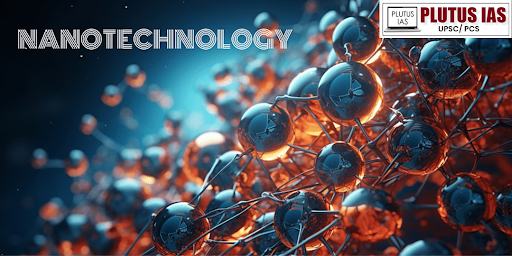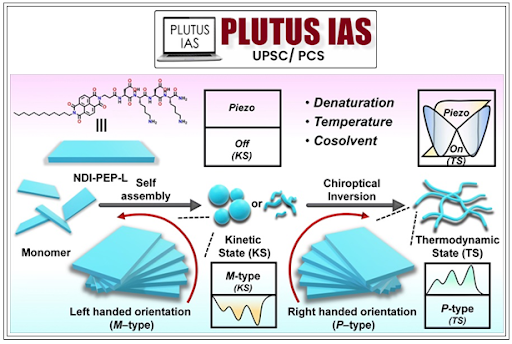22 Nov Advancing the Future: The Growth and Impact of Nanotechnology in India”
This article covers “Daily Current Affairs” and topic details of Advancing the Future: The Growth and Impact of Nanotechnology in India”
Syllabus mapping:
GS-3: Science and Technology: Recent development in the field of Nanotechnology.
For Prelims:
What is nanotechnology? various government initiatives in this regard? Carbon nanotubes and their applications?
For Mains:
What is the recent development in Nanotechnology, its significance, challenges in the use of this technology, and the way forward?
Why in the News?
Indian researchers have developed peptide-based tunable piezoresponsive nanomaterials with enhanced properties by controlling their self-assembly pathways. These materials can respond to mechanical stimuli and have potential applications in energy harvesting, biodevices, soft robotics, flexible electronics, and high-precision sensing devices, marking a significant advancement in nanotechnology for next-generation innovations.
Nanotechnology
Nanotechnology involves the development and use of techniques to study physical phenomena and create new devices and materials at the nanoscale (1-100 nanometers). It has significant implications across multiple fields due to its unique properties and applications.

Recent Key findings:
Controlled Supramolecular Self-Assembly: Researchers successfully manipulated the self-assembly processes of peptides by adjusting various parameters such as temperature and solvent composition, which is crucial in determining the final nanostructure and its properties.
Piezoresponsive Characteristics: The self-assembled peptide-based nanomaterials exhibited tunable piezoelectric behavior, allowing them to generate electrical charges in response to mechanical stress. This enhances their functionality in various applications.
Structural Asymmetry: The ability to create organized and asymmetric structures within the nanomaterials is essential for inducing piezoelectric properties, contributing to their responsiveness to mechanical stimuli.
Chiroptical Switching: The researchers observed a rare phenomenon where the rotation of polarized light switched direction during the denaturation of peptides, linked to the structural changes in the nanomaterials. This unique property can influence nanostructural formation, producing nanoparticles and nanofibers.
Dynamic Material Properties: The study demonstrates how alterations in the assembly process and external conditions can lead to significant changes in material properties, paving the way for the design of materials with customized functionalities.

Key Areas of Application:
Materials and Manufacturing: Nanotechnology has enabled the development of carbon nanotubes, which are used to create aerospace and automotive composites that are significantly stronger, lighter, and more durable than traditional materials.
Electronics and Computing: Quantum dots, a breakthrough in nanotechnology, are now used in QLED televisions to produce vibrant and energy-efficient displays, revolutionizing visual technology.
Telecommunications and IT: Nanoantennas are paving the way for ultra-fast and reliable 5G networks, enhancing communication systems and enabling faster data transfer.
Medicine and Health: Nanoparticles are being used for targeted drug delivery in cancer treatments, allowing medicines to attack cancer cells specifically while minimizing side effects on healthy tissues.
Environmental Applications: Nano-coated membranes are employed in advanced water purification systems, making it possible to remove contaminants and desalinate seawater more effectively.
Agriculture: Nanosensors are transforming farming by monitoring soil health in real-time, providing data on nutrient and moisture levels to optimize crop yields.
Energy: Nanomaterials, such as graphene, are improving the performance of lithium-ion batteries, leading to faster charging and longer-lasting energy storage solutions.
Chemical and Biological Technologies: Nanostructured catalysts are revolutionizing industrial chemical processes by significantly increasing reaction efficiency and reducing energy consumption.
Challenges to Strengthening Nanotechnology in India
Funding Gap from the Government: Despite initiatives like the National Nanotechnology Mission, India’s R&D expenditure remains around 0.7% of GDP, far below countries like the US (2.7%) and China (2.1%). This gap hampers sustained progress in nanotechnology research and infrastructure.
Long Stagnation Period: Nanotechnology development often involves a lengthy research-to-implementation cycle, with technologies taking 10-15 years to reach commercialization. The absence of sufficient early-stage funding and incubators further delays progress.
Limited Research Facilities: Only a select few institutions, like IISc and IITs, have access to state-of-the-art nanofabrication facilities. Over 60% of India’nanotechnology research output comes from these institutes, highlighting regional imbalances in resources and capabilities.
Lack of Commercialization: A 2022 report by NITI Aayog stated that only 20-30% of nanotechnology innovations in India progress from research to market. Weak collaboration between academia and industry, as well as limited venture capital investment, restricts the transition of technologies to scalable applications.
Insufficient Industry Collaboration: Indian industries often lack awareness or expertise in nanotechnology applications. A FICCI report highlighted that less than 5% of Indian manufacturing firms integrate nanotechnology into their processes, compared to over 20% in advanced economies.
Shortage of Skilled Workforce: Nanotechnology requires interdisciplinary expertise in physics, chemistry, and biology. However, India produces less than 10% of the global nanotechnology PhDs, creating a skills gap that limits innovation and scalability.
Inadequate Regulation and Standards: The lack of clear guidelines on the safe use and disposal of nanomaterials poses environmental and health risks. According to a TERI study, India lags behind countries like the US and EU in establishing regulatory frameworks for nanotechnology.
High Import Dependency: A majority of advanced nanotechnology tools and equipment, such as electron microscopes and nanolithography systems, are imported, making them expensive and delaying research. India’s import dependency on such equipment exceeds 80%, as reported by the Department of Science and Technology (DST).
Environmental and Ethical Concerns: Public awareness about the potential risks of nanotechnology, such as nanoparticle toxicity and environmental damage, remains low. The Global Nanotechnology Risk Report (2023) warned that inadequate risk management can slow adoption and lead to public resistance.
Way Forward to Deepening Nanotechnology in India:
Strengthening Research and Innovation Ecosystem: Expanding the Centre of Excellence in Nanoelectronics (CEN) to more institutions across India will ensure equitable access to advanced facilities. Programs like the Indian Nanoelectronics Users Programme (INUP-i2i) can be extended to smaller institutions and startups to promote broader participation.
Enhancing Commercialization Efforts: Stronger industry-academia partnerships must be promoted to accelerate the commercialization of research outputs. Collaborations similar to those facilitated by CEN, where technologies are licensed to startups, should be encouraged. Dedicated prototyping and incubation facilities supported by government schemes like Startup India will help bridge the gap between research and scalable manufacturing.
Increasing Funding and Reducing Import Dependency: Increasing R&D expenditure to at least 1.5% of GDP, aligning with the Atal Innovation Mission, can drive nanotechnology advancements. Establishing domestic production units for critical nanotechnology tools will reduce the current 80% import dependency, as highlighted by the Department of Science and Technology (DST).
Skill Development and Education: Nanotechnology education should be integrated into undergraduate and postgraduate curricula under initiatives like Skill India. Specialized training programs in nanofabrication, design, and computational nanoelectronics can build a robust talent pool. Increasing the number of funded PhD programs will double India’s contribution to global nanotechnology research.
Developing Regulatory Frameworks: Comprehensive safety guidelines for nanotechnology applications must be developed to ensure ethical usage and minimize environmental risks. The framework should draw insights from TERI’s studies and international standards, ensuring India remains competitive in adopting and regulating nanotechnology.
Leveraging Government Flagship Programs: The National Nanotechnology Mission can expand its funding focus to emerging applications like quantum computing and UV LEDs. Programs like Make in India and Digital India should support the domestic manufacturing of nanotechnology products, emphasizing sensors, IoT devices, and energy-efficient systems.
Collaboration with Global Institutions: Establishing international collaborations with leading countries like the US, Japan, and Germany will provide access to advanced tools and expertise. Participation in global forums will keep India aligned with cutting-edge developments, supported by schemes like India’s GIAN initiative (Global Initiative of Academic Networks).
Monitoring: A centralized body under MeitY or DST should oversee nanotechnology projects to ensure alignment with national priorities. Regular publication of reports on patents filed, commercialized innovations, and economic impact metrics can help measure progress and guide policy refinement.
Conclusion
India’s journey toward becoming a global leader in nanotechnology requires consistent efforts in research, funding, skill development, and industry collaboration. By leveraging existing initiatives and addressing current challenges, India can establish itself as a hub for nanotechnology innovation and drive its socio-economic transformation.
Download Plutus IAS Current Affairs ENG 22nd Nov 2024
Prelims Question:
Q. With reference to carbon nanotubes (CNTs), consider the following statements:
1. Single-walled carbon nanotubes (SWCNTs) can be idealized as cutouts from a two-dimensional graphene sheet rolled up to form a hollow cylinder.
2. Multi-walled carbon nanotubes (MWCNTs) consist of multiple layers of carbon atoms arranged in a nested, tube-in-tube structure.
3. Carbon nanotubes exhibit exceptional tensile strength due to the covalent sp² bonds formed between carbon atoms.
How many of the above-given statements are correct?
A. Only one
B. Only two
C. All three
D. None
ANSWER: C
Mains Question:
Q. Explain the role of government schemes and programs in promoting nanotechnology research and innovation in India. How do these initiatives help in bridging the gap between academia and industry?
(Answer in 250 words)




No Comments